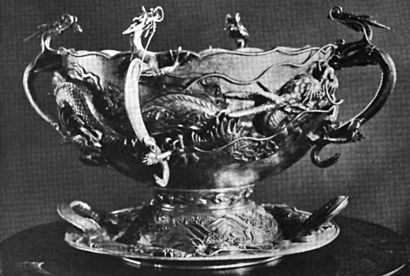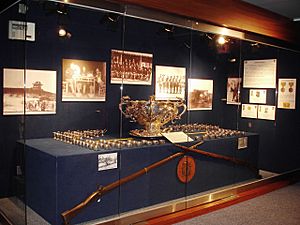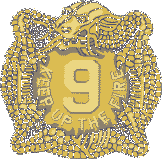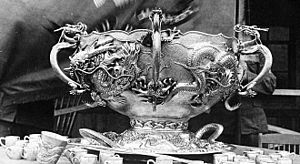Liscum Bowl facts for kids
Quick facts for kids Liscum Bowl |
|
|---|---|

The Liscum Bowl, circa 1909
|
|
| Artist | Arthur & Bond Company |
| Completion date | 2 November 1902 |
| Medium | Sterling silver |
| Dimensions | (1'9" in × 3'3" in) |
| Weight | 95 pounds (43 kg) |
| Location | Fort Carson, Colorado |
| 38°33′20″N 104°50′33″W / 38.55556°N 104.84250°W | |
| Owner | 9th Infantry Regiment |
The Liscum Bowl is a special sterling silver bowl set. It was made in 1902 from silver (called bullion) that the U.S. Army found during a big event in China called the Boxer Rebellion. A Chinese leader named Li Hung Chang gave the silver to the 9th Infantry Regiment. He was thanking them for helping China's government, the Qing dynasty. The bowl honors Colonel Emerson H. Liscum. He was the regiment's leader and died in a battle called the Battle of Tientsin on July 13, 1900.
The Liscum Bowl is one of the largest of its kind. The U.S. Army calls it "one of the foremost trophies of any American regiment." For many years, it was shown at the 2nd Infantry Division Museum in Korea. It was the most valuable item there, worth over $5 million. In 2018, the Liscum Bowl moved to Fort Carson, Colorado.
What is the Liscum Bowl?
The silver set includes the main bowl, a ladle, a tray, and many cups. Its style is from the late Meiji period in Japan. The whole set weighs about 95 pounds (43 kg). The bowl itself is 2 feet 4 inches (71 cm) across. It measures 3 feet 3 inches (99 cm) from handle to handle and is 1 foot 9 inches (53 cm) tall. It can hold about 15 gallons (57 liters) of liquid. The ladle is 2 feet 1½ inches (65 cm) long.
The bowl has four handles shaped like Imperial dragons. These dragons look like they are peering over the edge of the bowl. The regiment itself suggested this design.
Experts have praised the detailed artwork on the bowl. A report from 1920 said the dragon designs were excellent examples of Japanese craftsmanship. This type of detailed metalwork is called Repoussé and chasing.
The bowl has Colonel Liscum's name engraved on it, along with the date he died. This started a tradition. The silver cups that come with the bowl have the names of all officers. These officers served with the 9th Regiment in Asia between 1900 and the Korean War.
How the Liscum Bowl Was Made
The Boxer Rebellion was a violent uprising in China between 1899 and 1901. It was against foreigners and Christians. The United States was part of a group of countries called the Eight-Nation Alliance. This group sent armies to China to protect their people and businesses.
Only a few thousand Americans were sent to China. These included members of the 9th Infantry Regiment and some Marines. Colonel Emerson H. Liscum led the 9th Infantry Regiment. During the Battle of Tientsin on July 13 and 14, 1900, Colonel Liscum was badly hurt. A sniper shot him while his regiment was attacking the city walls. Before he died, Liscum told his soldiers, "Keep up the fire!" These famous last words became the regiment's official motto.
After the city fell, it was divided among the different countries. On July 15, 1900, two days after the battle, soldiers found a government building. It was full of silver and coins. This building was in the American part of the city. The 9th Infantry immediately guarded the silver.
The heat from the fire had melted some of the silver bars together. Two large, melted pieces of silver were saved last. These two pieces weighed about 90 pounds (41 kg) together.
Later, a Chinese leader named Li Hung Chang gave these two melted silver pieces to the 9th Infantry Regiment. This was a thank-you gift from the Chinese government. It showed their appreciation for the regiment's help in taking back the city and protecting the silver.
The officers of the regiment decided to use the melted silver to create a special trophy. They wanted it to be a punch bowl. Before leaving China, Chinese silversmiths made 52 cups from some of the silver. In 1902, the rest of the melted silver was sent to Japan. There, Japanese silversmiths at a company called Arthur & Bond made the ornate bowl, ladle, and tray. They followed specific instructions from the regiment.
The entire set was finished on November 2, 1902. It was first shown in a store window in Japan. Sadly, the ladle was stolen. Part of it was quickly found and fixed. The thief was sent to prison.
The repaired set was then sent to the United States. It traveled by ship through the Suez Canal. In April 1903, it was finally given to the regiment at Madison Barracks, New York.
Over the years, the Liscum Bowl traveled with the regiment. It was displayed for many years. During World War I and World War II, it was kept safe in a bank vault in San Antonio.
In 2003, the bowl needed a lot of repair work. It was dented, crushed, and had old, bad repairs. Missing pieces of the dragon designs were also fixed.
After being fully restored, the Liscum Bowl was shown at the United States Army Center of Military History in Washington, D.C. It returned to Korea in 2006. There, it was displayed at the Camp Red Cloud museum for 12 years.
In 2018, the Liscum Bowl moved permanently to Fort Carson, Colorado. Colonel Liscum had spent time in Colorado Springs, Colorado before the Boxer Rebellion. The bowl was shown in a special ceremony. One of Colonel Liscum's family members spoke at the event.




